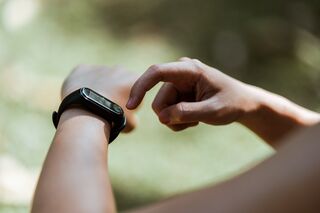Psychiatry
Fitbit, Apple Watch: How Wearables Could Transform Psychiatry
Interview with psychiatrist and early career investigator Michael Kirschenbaum.
Posted March 31, 2022 Reviewed by Vanessa Lancaster
Key points
- Kirschenbaum is turning to digital innovation to help bridge the gaps often found in traditional psychiatric clinical care.
- Kirschenbaum is researching whether a digitally augmented care model improves clinical outcomes and patient satisfaction.
- With digitally augmented care, real-time data provides between-visit information.
- Researchers must consider safety, privacy, and care.

Look down. You might be wearing one right now; a smartwatch. The Apple Watch, FitBit, Amazon’s Halo, or any other version of these wearables are powerful health tools that give us access to real-time data literally at our fingertips (well, on our wrist).
These tech-connected fitness bands can monitor our heart rate, oxygen level, steps, sleep, levels of activity, even how long we’ve been standing still. Beyond our physical health, researchers are looking to harness these valuable data paired with other novel digital innovations to aid in psychiatric care.
One such psychiatrist and early career investigator is Michael Kirschenbaum from Zucker Hillside Hospital and the Feinstein Institutes for Medical Research. From those smartwatches to apps and other digital interventional tools, Kirschenbaum is turning to digital innovation to help bridge the gaps often found in traditional psychiatric clinical care.
I sat down with Kirschenbaum to learn more about his work and where he sees the future of psychiatry headed in this digital age.
Birnbaum: Tell me about your area of research and focus?
Kirschenbaum: Absolutely! In taking a zoomed-out approach, my work has largely focused on developing a digital care delivery model that allows patients and providers to access a suite of integrated digital tools, all designed to address notable problem areas and gaps in traditional psychiatric clinical care. Some examples of digital tools I refer to include wearable sensors, care management apps, communication platforms, etc.
Birnbaum: Where is the field of psychiatry lagging? Perhaps in new diagnostic tools, treatment options ...
Kirschenbaum: Psychiatry has long been maligned for lacking objective measures. It is true that almost all of our treatment-related decision-making is based on the self-report of our patients. It would be nice to have easy to employ tests (like a blood test) that could tell us if someone is developing psychosis or depression.
Human behavior is immeasurably complex compared to the physiology of many other medical specialties. I am not sure this means psychiatry is lagging per se; I think it is also part of what makes psychiatry meaningful and interesting. We are treating human beings, not responding algorithmically to lab results. That being said, I think there are certainly unique challenges for the field, particularly when ensuring quality standards, diagnostic approaches, etc.
Birnbaum: How have wearables like Fitbit and Apple Watches changed the mental health field?
Kirschenbaum: These types of devices are really quite new. They have not made their way into routine clinical care in any measurable way yet. Still, there is already a ton of excitement surrounding wearable devices and their potential to capture continuous objective data.
For over a century, psychiatry has been without any between-visit data. As devices and other technologies give us a deeper understanding of what goes on between clinical visits, I think we will start seeing their potential come to life in really robust ways. These devices carry the vast potential to transform the way we deliver psychiatric care and how we understand our patients, but they are only part of the picture.
Birnbaum: You have an exciting study underway; tell me about that.
Kirschenbaum: Yes, for some background, our group at Zucker Hillside Hospital and the Feinstein Institutes has many researchers investigating different digital tools. We have been looking for a way to integrate these tools into one unified offering that can adapt to incorporate new interventions when they are clinic-ready. To achieve this, we landed on a care management platform developed by a company called Valera Health.
We have had the good fortune of a great collaborative relationship with the team at Valera and a supportive industry sponsor in Sunovion Inc, and the end result has been really exciting.
The platform has allowed us to integrate meaningful measurement-based care and wearable data from Fitbits (e.g., sleep and activity) into clinical workflows while improving and modernizing communication between patients and care teams. The formal title of the study is “App-enabled Care Management for Illness Monitoring and Reduction of Treatment Failure in Schizophrenia and Bipolar Disorder.” The study assesses whether this digitally augmented care model improves clinical outcomes and patient satisfaction.
We are looking to enroll 200 patients with bipolar disorder and schizophrenia and follow them for six months. Up to this point, we successfully recruited patients and are up to about 150 enrolled, which speaks to the excitement about these new technologies from the patient side.
From my perspective, the most exciting part has been the positive feedback we have received from patients and providers. When we consider this is only our first step in bringing a "digital psychiatry" program to life, our experiences have us really excited about where things are headed.
Birnbaum: What’s your vision for the future of psychiatry? How can wearables and other devices be incorporated?
Kirschenbaum: That’s an interesting one; if you asked me this before we started the Valera study, I would have talked almost exclusively about predicting relapse with passively collected data, and that still excites me, but as I have seen patients interact with the platform and devices a bit more, I am equally excited about the potential a digital care model has to empower patients to monitor and manage their own illness.
Shared decision-making in psychiatry is often a tough nut to crack, but having patients generate and view their own data from symptom surveys and wearable sensors allows providers and patients to look at data together and collaboratively develop treatment plans based on what they have in front of them—having new metrics to track things like sleep, heart rate, and activity should hopefully give both patients and care teams a much deeper understanding of how behaviors interact with psychiatric symptoms.
So, I hope the future will unlock the potential of digital phenotyping and relapse prediction. Still, I am most excited about the potential digital psychiatry has to strengthen the provider-patient relationship and how it can enable patients to take a more active role in their treatment.
Birnbaum: Are there things we need to watch out for, like patient safety or privacy? False readings?
Kirschenbaum: I think with any new technology being developed for use in medicine, providers and researchers need to be extremely attentive to the issue of privacy first and foremost. Our patients trust us to do our due diligence, and we need to make sure we are conscientious about this. We are obligated to inform them about how the data is being used, who has access to the data, and ensure we give them the option to not participate without consequence.
With regard to safety, our experience has been that patients seem to be safer when using these tools. One reason for this impression is that we can capture when a patient feels unwell or suicidal much easier outside of the interval appointment model (currently employed in virtually all psychiatric clinics), where patients often go one to two months without speaking to their providers.
False readings are a relatively easy fix when using technology the right way. Everything needs to be put in context, and if you see something concerning, you can always call the patient to check how they are doing. In the hospital, we get false readings, be it on blood work, EKGs, or blood pressure. The way I view it, technology isn’t here to replace common sense or clinical judgment; it is just another tool to support providers and patients.
Birnbaum: Ten, fifteen years from now, where do you think the field of mental health and how we treat disease be?
Kirschenbaum: I think that the field of medicine has a reputation for moving a bit slower in terms of innovation than we sometimes expect, but I hope that passive sensor data from mobile phones and wearables will become routine tools in psychiatry, that objective sleep data, activity, etc. will allow patients to understand themselves and their illnesses in a much richer way. Naturally, this should lead to improved outcomes and tailored treatments that would enable individuals affected by mental illness to achieve more robust functional recovery and lead more fulfilling lives.
I can’t promise that this will happen so quickly, based on how long it typically takes for research to make its way to the clinic, but I hope that technology will allow for more rapid uptake of these exciting developments.
Birnbaum: Anything else you want to add?
Kirschenbaum: I would like to thank the rest of our team for working tirelessly on the Valera study. Megan Walsh, our project managers, Devin Oliva, Emily Moyett, and Nimisha Singh have served as study coordinators and digital care managers. They have been truly incredible to work with and are the people on the front lines of the digital psychiatry revolution bringing these ideas to life.
Any innovation only succeeds when you have passionate people working to bring it to the people who stand to benefit from it the most, and though I may be biased here, I think we have an all-star team.




